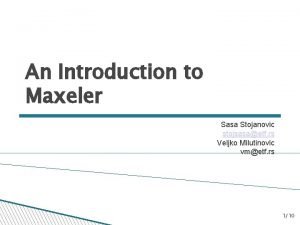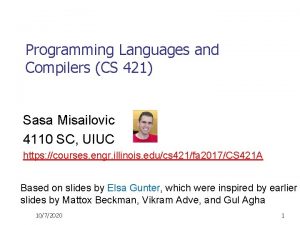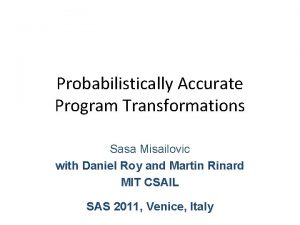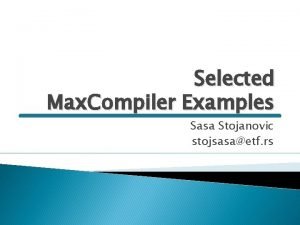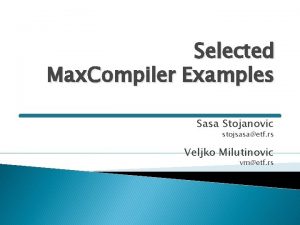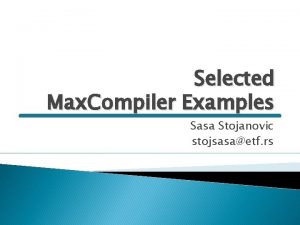An Introduction to Maxeler Sasa Stojanovic stojsasaetf rs










- Slides: 10

An Introduction to Maxeler Sasa Stojanovic stojsasa@etf. rs Veljko Milutinovic vm@etf. rs 1/10

Essence of the Maxeler Approach! Compiling below the machine code level brings speedups; also a smaller power, volume, and cost. The price to pay: The machine is more difficult to program. Consequently: Ideal for WORN applications : ) Examples: Geo. Physisc, banking, dataminig in social networks, . . . 2/10

Examples of Maxeler Applications! 3/10

Examples of Maxeler Applications! 4/10

Examples of Maxeler Applications! 5/10

How-to? What-to? Introduction One has to know how to program Maxeler machines, in order to get the best possible speedup out of them! For some applications (G), there is a large difference between what an experienced programmer achieves, and what an un-experienced one can achieve! For some other applications (B), no matter how experienced the programmer is, the speedup will not be revolutionary (may be even <1). 6/10

The Essential Figure: t. CPU = N * NOPS * CCPU*Tclk. CPU /Ncores. CPU t. GPU = N * NOPS * CGPU*Tclk. GPU / Ncores. GPU Introduction t. DF = NOPS * CDF * Tclk. DF + (N – 1) * Tclk. DF / NDF Assumptions: 1. Software includes enough parallelism to keep all cores busy 2. The only limiting factor is the number of cores. 7/10

Bottomline: Introduction When is Maxeler better? if the number of operations in a single loop iteration is above some critical value ADDITIVE SPEEDUP ENABLER then more data items means more advantage for Maxeler. ADDITIVE SPEEDUP MAKER In other words: More data does not mean better performance if the #operations/iteration is below a critical value. Conclusion: If we see an application with a small #operations/iteration, then it is possibly (not always) a “what-not-to” application, and we better execute it on the host; else we will (or may) have a slowdown. 8/10

To have it more concrete: Introduction Maxeler: One new result in each cycle e. g. Clock = 100 MHz Period = 10 ns One result every 10 ns [No matter how many operations in each loop iteration] Consequently: More operations does not mean proportionally more time; however, more operations means higher latency till the first result. CPU: One new result after each iteration e. g. Clock=10 GHz (!? ) Period = 100 ps One result every 100 ps times #ops [If #ops > 100 => Maxeler is better, although it uses a slower clock] Also: The CPU example will feature an additional slowdown, due to memory hierarchy access and pipeline related hazards => critical #ops (bringing the same performance) is significantly below 100!!! 9/10

An Introduction to Maxeler Q&A 10/10
